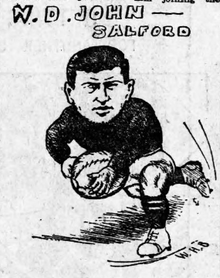Dai John
W. David "Dai" John (birth unknown – death unknown) was a Welsh rugby union and professional rugby league footballer who played in the 1900s and 1910s. He played club level rugby union (RU) for Penygraig RFC, as a half-back, and representative level rugby league (RL) for Wales, and at club level for Salford, as a fullback or stand-off, i.e. number 1 or, 6.[1][2]
 | |||||||||||||||||||||||||||||||||||||||||||
Personal information | |||||||||||||||||||||||||||||||||||||||||||
|---|---|---|---|---|---|---|---|---|---|---|---|---|---|---|---|---|---|---|---|---|---|---|---|---|---|---|---|---|---|---|---|---|---|---|---|---|---|---|---|---|---|---|---|
| Full name | David John | ||||||||||||||||||||||||||||||||||||||||||
| Born | Wales | ||||||||||||||||||||||||||||||||||||||||||
| Died | unknown | ||||||||||||||||||||||||||||||||||||||||||
Playing information | |||||||||||||||||||||||||||||||||||||||||||
| Height | 1.60 m (5 ft 3 in) | ||||||||||||||||||||||||||||||||||||||||||
| Weight | 70 kg (150 lb; 11 st 0 lb) | ||||||||||||||||||||||||||||||||||||||||||
Rugby union | |||||||||||||||||||||||||||||||||||||||||||
| Position | Half-back | ||||||||||||||||||||||||||||||||||||||||||
| |||||||||||||||||||||||||||||||||||||||||||
Rugby league | |||||||||||||||||||||||||||||||||||||||||||
| Position | Fullback, Stand-off | ||||||||||||||||||||||||||||||||||||||||||
| |||||||||||||||||||||||||||||||||||||||||||
Source: [1] | |||||||||||||||||||||||||||||||||||||||||||
Playing career
Championship Final appearances
During Dai John's time there was Salford's 5-3 victory over Huddersfield in the Championship Final during the 1913–14 season.
Challenge Cup Final appearances
Dai John played stand-off in Salford's 0-5 defeat by Bradford F.C. in the 1906 Challenge Cup Final during the 1905–06 season at Headingley Rugby Stadium, Leeds on Saturday 28 April 1906.[3]
Club career
Dai John originally played rugby union, turning out at half-back for Penygraig RFC in the Rhondda.[4] While still a teenager he switched codes to rugby league.[4] John was considered a "Probable" for the 1910 Great Britain Lions tour of Australia and New Zealand, but ultimately he was not selected for the tour.[5] Writing at the time in the Evening Express, their rugby league correspondent suggested that it was John's height, standing at 5 foot 3 inches, that cost him his place.[4]
References
- "Statistics at rugbyleagueproject.org". rugbyleagueproject.org. 31 December 2011. Retrieved 1 January 2012.
- Williams, Graham; Lush, Peter; Farrar, David (2009). The British Rugby League Records Book. London League. pp. 108–114. ISBN 978-1-903659-49-6.
- Irvin Saxton (publish date tbc) "History of Rugby League – № 11 – 1905–06". Rugby Leaguer ISBN n/a
- "Welshmen Up North – Mystery of Dai Furnish". newspapers.library.wales. 10 September 1910. Retrieved 17 January 2019.
- "Northern Union – The Colonial Football Tour – Probable Players". paperspast.natlib.govt.nz. 31 December 2011. Retrieved 1 January 2012.